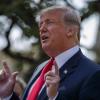
President Trump’s ability to wangle a new deal from NAFTA partners Mexico and Canada will give the White House leverage to take a harder line in the escalating trade war with China, administration bac
President Trump’s ability to wangle a new deal from NAFTA partners Mexico and Canada will give the White House leverage to take a harder line in the escalating trade war with China, administration backers said Monday.
“Now the focus turns to China, where President Trump can resume his negotiations from a position of strength,” said Chris Garcia, a former Commerce Department deputy director.
He said Monday that the United States-Mexico-Canada Agreement is a blow to Beijing because it will create more hurdles for Chinese-made auto parts to enter the U.S. market and undercut Beijing’s divide-and-conquer strategy.
Trade analysts said a provision in the agreement dealing with currency manipulation gives Mr. Trump a template to attack Beijing for what critics say is a long pattern of driving down the yuan to benefit Chinese exporters.
Although it’s unclear when the next round of U.S.-Chinese trade talks will occur — Beijing halted negotiations last week after Mr. Trump ordered tariffs on a fresh $200 billion in Chinese imports — Mr. Trump clearly signaled that he is ready to play hardball.
“It’s a privilege for China to do business with us,” Mr. Trump told reporters at the White House while announcing the deal with Canada and Mexico.
“China wants to talk very badly,” said Mr. Trump, crediting his willingness to use tariffs and other measures to rebalance the trading relationship between the globe’s two biggest economies. “Frankly, it’s too early to talk. Can’t talk now because they’re not ready, because they’ve been ripping us for so many years.”
Some administration officials argued that the president now has momentum on his side as he ramps up talks with China and Japan on new trade deals.
“The dominoes are falling, and it is good news for U.S. farmers,” Agriculture Secretary Sonny Perdue said in a statement.
But some analysts predicted that, as tumultuous as the USMCA negotiations were over recent months, a breakthrough on trade with China is likely to be even more elusive.
“Unfortunately, the China story is a lot more complicated,” said Luis Costa, a top strategy analyst with Citibank.
Mr. Costa argued in an interview on CNBC that the Trump administration’s immediate goals for the trade talks with China are not entirely clear.
“What does the U.S. really want to achieve in the short term so we can finalize and mute the noise? We don’t quite know,” he said. “So I think that the story will probably be with us for years, not months.”
Chinese officials had no immediate response to the Canada deal, and stock markets in Hong Kong and on the mainland were closed Monday. Other Asian stock markets were mixed as traders struggled to understand the deal.
Complex problem
China poses a problem of far greater magnitude and complexity for U.S. trade negotiators. In addition to breaking down traditional trade and tariff barriers, Washington is demanding changes to China’s rules on such matters as technology-sharing and intellectual property rights.
Although Mr. Trump likes to highlight China’s recent economic and financial woes, Chinese President Xi Jinping faces far fewer domestic pressures to cut a deal than do the democratically elected leaders of Canada and Mexico.
The U.S. is China’s largest single export market, taking in just under a fifth of all Chinese exports. The U.S. is the third-largest importer into China, trailing South Korea and Japan.
The planned U.S.-Mexico-Canada Agreement, assuming the three countries ratify it, takes off the table any hopes China may have had of enlisting Mexico City and Ottawa in a broad alliance against Mr. Trump’s trade agenda. The breakthrough over the weekend could strengthen Mr. Trump’s hand by aligning the U.S., Mexico and Canada as three-way trade partners, with China on the outside looking in.
One area of the agreement that may have an immediate impact for China is the export of car and auto parts to the U.S. The agreement effectively caps imports from Canada and Mexico at 2.4 million vehicles and $90 billion worth of auto parts annually. Anything above that triggers a 25 percent tariff.
The agreement also requires 75 percent of the value of vehicles sold in the U.S. to be produced within the NAFTA market and stipulates that 40 percent to 45 percent of a vehicle’s value be made in areas paying at least $16 an hour.
A report Monday by Investors Business Daily maintained that “China is a prime target of the new auto part restrictions” that aim to “curb the use of components produced outside North America.”
“This is a major victory for the U.S. in re-orienting the supply chain away from Southeast Asia and back to North America …,” Mr. Garcia said. “China was using Mexico to game the system.”
Other parts of the accord also appear to have China clearly in mind. Alexandre Moreau, a public policy analyst at the Montreal Economic Institute, pointed to a provision in the agreement that may effectively block Canada and Mexico from cutting their own bilateral trade deals with China and other major trading powers.
“That’s something that really worries me,” Mr. Moreau said in an interview on CNBC.
Others expressed hope that the USMCA will result in such a boon for North America that such concerns are irrelevant.
Mr. Garcia, the former U.S. Commerce Department official, argued in remarks circulated to reporters that the deal is “an effort to reorient the supply chain to North America.”
“The de-industrialization of the United States ended last night,” he said. “This is a major victory for the U.S. in re-orienting the supply chain away from Southeast Asia and back to North America.”






